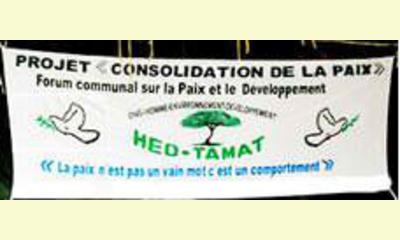|
|
The NGO HED Tamat for a Culture of Peace in Agadez, Niger
un articulo por Ibrahim Manzo DIALLO for Aïr Info, news Niger (abridged)
17, 18 and 19 December last year, a Regional Forum focused on the theme of Peacebuilding and Development was organized by the NGO Agadez HED-Tamat in close collaboration with regional authorities, technical services, tribal authorities, local elected officials, organizations of civil society and representatives of communities. This forum was the synthesis and assessment of a series of eleven municipal fora.

click on photo to enlarge
It should be noted that regional authorities, headed by the Governor of the State, Colonel Garba Major Elhadji Maïkido and the President of the Regional Council, Mohamed Anacko personally took part in the work of this forum. This shows the importance that these authorities attribute to issues of peace, security and development. . . The Governor noted that "The situation in some countries in the Sahel-Sahara, the armed conflict that persists in Mali and the political instability facing Libya where many of our compatriots are living must challenge us at every moment. The developments in these countries may eventually have influences on the stability of the entire sub-region. "
Considering the recent developments in Mali, the concern expressed by the Colonel and Major Maïkido and shared by many forum participants now seems almost prescient. Indeed, the intervention of French forces in the conflict in Mali will have consequences both locally and at the sub-regional level. Beyond changing the balance of power between the belligerents, this turn of the conflict, could push people to flee from their homes, not only civilians who will join the refugee camps, but also "elements" more or less structured the various armed groups that have lost ground in their strongholds. . .
To strengthen the peace and security so dearly found in the Agadez region in particular and Niger in general, the political and administrative authorities, local government officials, traditional leaders and the technical and financial partners must maintain firmly their responsibilities. . . The technical and financial partners must redouble efforts to support the government's efforts in consolidating peace. Indeed, as the saying goes, "prevention is better than cure". This is the time to invest in a culture of peace. . .
As for the NGO HED-Tamat, in accordance with its commitment to continue working in the Agadez Region, it must consolidate and strengthen its Culture of Peace Project. It must, as demanded by the regional forum, integrate all the municipalities of the region of Agadez in the dynamic of a culture of peace. The municipalities of Kawar (Department of Bilma) because of their geographical position are especially vulnerable and must not be omitted in any discussion related to the strengthening of peace and security.
(Click here for a French version of this article)
|








|
DISCUSSION
Pregunta(s) relacionada(s) al artículo :
In the face of armed conflicts in the Sahara-Sahel, Can a culture of peace be established?
* * * * *
Comentario más reciente:
:
As often occurs, in the Sahara-Sahel, in the face of the terrible violence of religious extremists in Mali, there is a dialectic so that the more the violence, the more the demand for a culture of peace.

|
|









